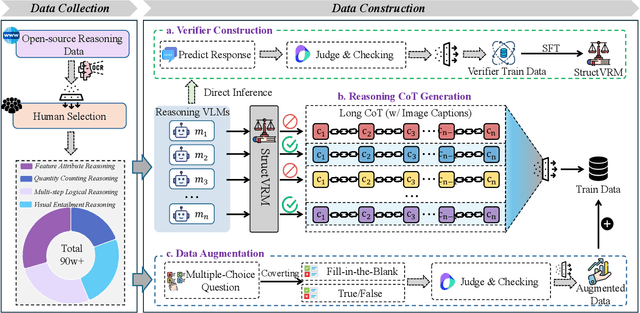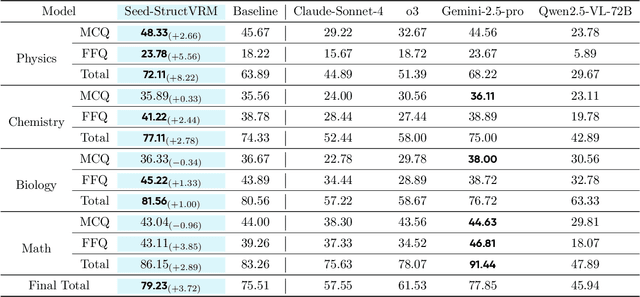Qi Chen
RPG: A Repository Planning Graph for Unified and Scalable Codebase Generation
Sep 19, 2025



Abstract:Large language models excel at function- and file-level code generation, yet generating complete repositories from scratch remains a fundamental challenge. This process demands coherent and reliable planning across proposal- and implementation-level stages, while natural language, due to its ambiguity and verbosity, is ill-suited for faithfully representing complex software structures. To address this, we introduce the Repository Planning Graph (RPG), a persistent representation that unifies proposal- and implementation-level planning by encoding capabilities, file structures, data flows, and functions in one graph. RPG replaces ambiguous natural language with an explicit blueprint, enabling long-horizon planning and scalable repository generation. Building on RPG, we develop ZeroRepo, a graph-driven framework for repository generation from scratch. It operates in three stages: proposal-level planning and implementation-level refinement to construct the graph, followed by graph-guided code generation with test validation. To evaluate this setting, we construct RepoCraft, a benchmark of six real-world projects with 1,052 tasks. On RepoCraft, ZeroRepo produces repositories averaging nearly 36K LOC, roughly 3.9$\times$ the strongest baseline (Claude Code) and about 64$\times$ other baselines. It attains 81.5% functional coverage and a 69.7% pass rate, exceeding Claude Code by 27.3 and 35.8 percentage points, respectively. Further analysis shows that RPG models complex dependencies, enables progressively more sophisticated planning through near-linear scaling, and enhances LLM understanding of repositories, thereby accelerating agent localization.
Hunyuan3D Studio: End-to-End AI Pipeline for Game-Ready 3D Asset Generation
Sep 16, 2025



Abstract:The creation of high-quality 3D assets, a cornerstone of modern game development, has long been characterized by labor-intensive and specialized workflows. This paper presents Hunyuan3D Studio, an end-to-end AI-powered content creation platform designed to revolutionize the game production pipeline by automating and streamlining the generation of game-ready 3D assets. At its core, Hunyuan3D Studio integrates a suite of advanced neural modules (such as Part-level 3D Generation, Polygon Generation, Semantic UV, etc.) into a cohesive and user-friendly system. This unified framework allows for the rapid transformation of a single concept image or textual description into a fully-realized, production-quality 3D model complete with optimized geometry and high-fidelity PBR textures. We demonstrate that assets generated by Hunyuan3D Studio are not only visually compelling but also adhere to the stringent technical requirements of contemporary game engines, significantly reducing iteration time and lowering the barrier to entry for 3D content creation. By providing a seamless bridge from creative intent to technical asset, Hunyuan3D Studio represents a significant leap forward for AI-assisted workflows in game development and interactive media.
Bitrate-Controlled Diffusion for Disentangling Motion and Content in Video
Sep 10, 2025Abstract:We propose a novel and general framework to disentangle video data into its dynamic motion and static content components. Our proposed method is a self-supervised pipeline with less assumptions and inductive biases than previous works: it utilizes a transformer-based architecture to jointly generate flexible implicit features for frame-wise motion and clip-wise content, and incorporates a low-bitrate vector quantization as an information bottleneck to promote disentanglement and form a meaningful discrete motion space. The bitrate-controlled latent motion and content are used as conditional inputs to a denoising diffusion model to facilitate self-supervised representation learning. We validate our disentangled representation learning framework on real-world talking head videos with motion transfer and auto-regressive motion generation tasks. Furthermore, we also show that our method can generalize to other types of video data, such as pixel sprites of 2D cartoon characters. Our work presents a new perspective on self-supervised learning of disentangled video representations, contributing to the broader field of video analysis and generation.
ResearchPulse: Building Method-Experiment Chains through Multi-Document Scientific Inference
Sep 03, 2025Abstract:Understanding how scientific ideas evolve requires more than summarizing individual papers-it demands structured, cross-document reasoning over thematically related research. In this work, we formalize multi-document scientific inference, a new task that extracts and aligns motivation, methodology, and experimental results across related papers to reconstruct research development chains. This task introduces key challenges, including temporally aligning loosely structured methods and standardizing heterogeneous experimental tables. We present ResearchPulse, an agent-based framework that integrates instruction planning, scientific content extraction, and structured visualization. It consists of three coordinated agents: a Plan Agent for task decomposition, a Mmap-Agent that constructs motivation-method mind maps, and a Lchart-Agent that synthesizes experimental line charts. To support this task, we introduce ResearchPulse-Bench, a citation-aware benchmark of annotated paper clusters. Experiments show that our system, despite using 7B-scale agents, consistently outperforms strong baselines like GPT-4o in semantic alignment, structural consistency, and visual fidelity. The dataset are available in https://huggingface.co/datasets/ResearchPulse/ResearchPulse-Bench.
StructVRM: Aligning Multimodal Reasoning with Structured and Verifiable Reward Models
Aug 07, 2025



Abstract:Existing Vision-Language Models often struggle with complex, multi-question reasoning tasks where partial correctness is crucial for effective learning. Traditional reward mechanisms, which provide a single binary score for an entire response, are too coarse to guide models through intricate problems with multiple sub-parts. To address this, we introduce StructVRM, a method that aligns multimodal reasoning with Structured and Verifiable Reward Models. At its core is a model-based verifier trained to provide fine-grained, sub-question-level feedback, assessing semantic and mathematical equivalence rather than relying on rigid string matching. This allows for nuanced, partial credit scoring in previously intractable problem formats. Extensive experiments demonstrate the effectiveness of StructVRM. Our trained model, Seed-StructVRM, achieves state-of-the-art performance on six out of twelve public multimodal benchmarks and our newly curated, high-difficulty STEM-Bench. The success of StructVRM validates that training with structured, verifiable rewards is a highly effective approach for advancing the capabilities of multimodal models in complex, real-world reasoning domains.
Lost in Pronunciation: Detecting Chinese Offensive Language Disguised by Phonetic Cloaking Replacement
Jul 10, 2025Abstract:Phonetic Cloaking Replacement (PCR), defined as the deliberate use of homophonic or near-homophonic variants to hide toxic intent, has become a major obstacle to Chinese content moderation. While this problem is well-recognized, existing evaluations predominantly rely on rule-based, synthetic perturbations that ignore the creativity of real users. We organize PCR into a four-way surface-form taxonomy and compile \ours, a dataset of 500 naturally occurring, phonetically cloaked offensive posts gathered from the RedNote platform. Benchmarking state-of-the-art LLMs on this dataset exposes a serious weakness: the best model reaches only an F1-score of 0.672, and zero-shot chain-of-thought prompting pushes performance even lower. Guided by error analysis, we revisit a Pinyin-based prompting strategy that earlier studies judged ineffective and show that it recovers much of the lost accuracy. This study offers the first comprehensive taxonomy of Chinese PCR, a realistic benchmark that reveals current detectors' limits, and a lightweight mitigation technique that advances research on robust toxicity detection.
PanTS: The Pancreatic Tumor Segmentation Dataset
Jul 02, 2025Abstract:PanTS is a large-scale, multi-institutional dataset curated to advance research in pancreatic CT analysis. It contains 36,390 CT scans from 145 medical centers, with expert-validated, voxel-wise annotations of over 993,000 anatomical structures, covering pancreatic tumors, pancreas head, body, and tail, and 24 surrounding anatomical structures such as vascular/skeletal structures and abdominal/thoracic organs. Each scan includes metadata such as patient age, sex, diagnosis, contrast phase, in-plane spacing, slice thickness, etc. AI models trained on PanTS achieve significantly better performance in pancreatic tumor detection, localization, and segmentation compared to those trained on existing public datasets. Our analysis indicates that these gains are directly attributable to the 16x larger-scale tumor annotations and indirectly supported by the 24 additional surrounding anatomical structures. As the largest and most comprehensive resource of its kind, PanTS offers a new benchmark for developing and evaluating AI models in pancreatic CT analysis.
Interpreting Chest X-rays Like a Radiologist: A Benchmark with Clinical Reasoning
May 29, 2025



Abstract:Artificial intelligence (AI)-based chest X-ray (CXR) interpretation assistants have demonstrated significant progress and are increasingly being applied in clinical settings. However, contemporary medical AI models often adhere to a simplistic input-to-output paradigm, directly processing an image and an instruction to generate a result, where the instructions may be integral to the model's architecture. This approach overlooks the modeling of the inherent diagnostic reasoning in chest X-ray interpretation. Such reasoning is typically sequential, where each interpretive stage considers the images, the current task, and the contextual information from previous stages. This oversight leads to several shortcomings, including misalignment with clinical scenarios, contextless reasoning, and untraceable errors. To fill this gap, we construct CXRTrek, a new multi-stage visual question answering (VQA) dataset for CXR interpretation. The dataset is designed to explicitly simulate the diagnostic reasoning process employed by radiologists in real-world clinical settings for the first time. CXRTrek covers 8 sequential diagnostic stages, comprising 428,966 samples and over 11 million question-answer (Q&A) pairs, with an average of 26.29 Q&A pairs per sample. Building on the CXRTrek dataset, we propose a new vision-language large model (VLLM), CXRTrekNet, specifically designed to incorporate the clinical reasoning flow into the VLLM framework. CXRTrekNet effectively models the dependencies between diagnostic stages and captures reasoning patterns within the radiological context. Trained on our dataset, the model consistently outperforms existing medical VLLMs on the CXRTrek benchmarks and demonstrates superior generalization across multiple tasks on five diverse external datasets. The dataset and model can be found in our repository (https://github.com/guanjinquan/CXRTrek).
LLM-Meta-SR: Learning to Evolve Selection Operators for Symbolic Regression
May 24, 2025Abstract:Large language models (LLMs) have revolutionized algorithm development, yet their application in symbolic regression, where algorithms automatically discover symbolic expressions from data, remains constrained and is typically designed manually by human experts. In this paper, we propose a learning-to-evolve framework that enables LLMs to automatically design selection operators for evolutionary symbolic regression algorithms. We first identify two key limitations in existing LLM-based algorithm evolution techniques: code bloat and a lack of semantic guidance. Bloat results in unnecessarily complex components, and the absence of semantic awareness can lead to ineffective exchange of useful code components, both of which can reduce the interpretability of the designed algorithm or hinder evolutionary learning progress. To address these issues, we enhance the LLM-based evolution framework for meta symbolic regression with two key innovations: bloat control and a complementary, semantics-aware selection operator. Additionally, we embed domain knowledge into the prompt, enabling the LLM to generate more effective and contextually relevant selection operators. Our experimental results on symbolic regression benchmarks show that LLMs can devise selection operators that outperform nine expert-designed baselines, achieving state-of-the-art performance. This demonstrates that LLMs can exceed expert-level algorithm design for symbolic regression.
Seeing the Trees for the Forest: Rethinking Weakly-Supervised Medical Visual Grounding
May 21, 2025Abstract:Visual grounding (VG) is the capability to identify the specific regions in an image associated with a particular text description. In medical imaging, VG enhances interpretability by highlighting relevant pathological features corresponding to textual descriptions, improving model transparency and trustworthiness for wider adoption of deep learning models in clinical practice. Current models struggle to associate textual descriptions with disease regions due to inefficient attention mechanisms and a lack of fine-grained token representations. In this paper, we empirically demonstrate two key observations. First, current VLMs assign high norms to background tokens, diverting the model's attention from regions of disease. Second, the global tokens used for cross-modal learning are not representative of local disease tokens. This hampers identifying correlations between the text and disease tokens. To address this, we introduce simple, yet effective Disease-Aware Prompting (DAP) process, which uses the explainability map of a VLM to identify the appropriate image features. This simple strategy amplifies disease-relevant regions while suppressing background interference. Without any additional pixel-level annotations, DAP improves visual grounding accuracy by 20.74% compared to state-of-the-art methods across three major chest X-ray datasets.
 Add to Chrome
Add to Chrome Add to Firefox
Add to Firefox Add to Edge
Add to Edge